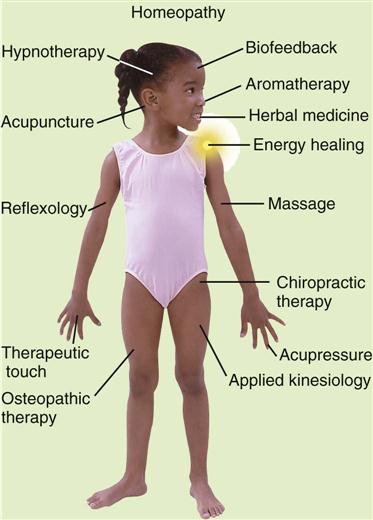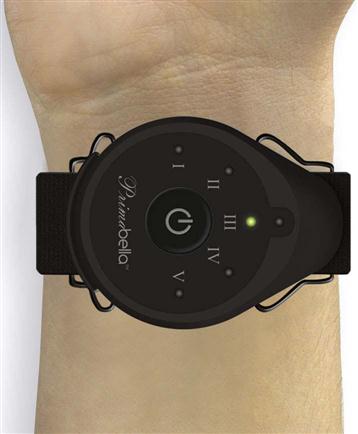Complementary and Alternative Therapies in Maternity and Pediatric Nursing
Objectives
1. Define each key term listed.
2. Define complementary and alternative medicine (CAM) therapy.
3. Identify the role of the nurse in CAM therapy.
4. Describe the involvement of the federal government in CAM therapy.
5. Discuss the integration of CAM therapy into nursing practice.
6. Discuss the impact on nursing care of patients who use CAM therapy.
7. State five types of CAM therapy in common use.
8. State three herbal products contraindicated in pregnancy.
9. State three herbal products commonly used in pediatrics.
10. State popular herbs used during menopause.
12. State three herbs that should be discontinued 2 weeks before surgery.
13. State the use of meridians, dermatomes, and reflexology lines in CAM therapy.
Key Terms
alternative therapy (p. 760)
aromatherapy (p. 765)
coin-rubbing (p. 763)
complementary therapy (p. 760)
dermatomes (DŬR-mă-tōmz, p. 764)
herbal medicine (p. 765)
hyperbaric oxygen therapy (HBOT) (p. 768)
meridians (mĕ-RĬD-ē-ănz, p. 764)
reflexology (p. 764)
Rolfing (RŎL-fĭng, p. 763)
shiatsu (shē-ĂHT-sū, p. 764)
![]() http://evolve.elsevier.com/Leifer
http://evolve.elsevier.com/Leifer
Complementary and Alternative Therapies
Complementary therapy refers to nontraditional (non-Western medical) therapy that is used with traditional or conventional (Western medical) therapy. An example would be the treatment of hypertension with medication plus relaxation or biofeedback techniques. Alternative therapy refers to unconventional or nontraditional therapy that replaces conventional or traditional therapy. Complementary and alternative medicine (CAM) therapies are also known as integrative therapy, integrative healing, and holistic healing. Although CAM therapy is used throughout the lifespan, this chapter focuses only on the common gynecological, obstetric, and pediatric practices.
Pediatric Use
The status of CAM research was reviewed by the Task Force on Complementary and Alternative Medicine. Their findings, published in a 2000 report, indicate that research is limited because of variations in content of CAM products and the fact that results of evidence-based research is usually published in foreign language journals and not easily accessible to U.S. pediatricians (Kemper, 2008). However, many CAM therapies are utilized effectively and integrated with traditional Western medicine. For example, the ketogenic diet has proven effective in some seizure disorders and chiropractic care for children is common practice, although evidence-based research and randomized controlled trials on both are lacking. Meditation, guided imagery, and biofeedback have been useful in managing pain control, anxiety, sleep disorders, asthma, and many other conditions. Acupuncture has been successful in the treatment of some headaches in children, and many pediatricians and gastroenterologists now recommend probiotics.
The National Center for Complementary and Alternative Medicine awarded the University of Arizona a 5-year grant to study pediatric CAM practices, and in 2004 an Integrative Pediatric Council was formed to compile evidence based practices in pediatrics. In 2007, Duke University Medical School designed a “living laboratory” to study effective use of CAM therapies. More comprehensive integration of CAM practices may be on the horizon.
The Nurse’s Role
Many CAM therapies are based on accepted theories such as the gate control theory of pain relief (see Chapter 7). Nurses have used complementary therapies such as imagery, journaling, therapeutic touch, humor, and support groups and therefore have an integral role in the development and assessment of CAM therapy. A large proportion of people worldwide use some sort of CAM therapy for adults and children, with complementary therapy readily accepted in Europe (Corrigan & Alfers, 2007). Knowledge concerning CAM therapy expands knowledge about health care practices used in many cultures. Cultural competence is sensitivity to and respect for practices and philosophies different from one’s own; the awareness and understanding of CAM therapy can enhance the cultural competence of nurses.
The focus of health care has changed, moving from the patient in the hospital to the patient in the home. The hospital setting is somewhat of a controlled environment, but nursing care in the home brings new challenges. As nurses enter this health care environment within the community, they will no longer be surrounded by familiar equipment, practices, and support personnel. Instead they will encounter some alternative health care practices involving patients who want increasing control over their health problems, need to be a part of the decision making process, and want to incorporate cultural beliefs and traditions into their care. In addition to accepting treatment prescribed by a traditional health care provider, the patient may also be consulting other healing authorities such as holistic practitioners, naturopaths, and nutritional consultants (Figure 34-1). Food therapy, vitamin and mineral supplements, herbal therapy, and acupressure are common forms of alternative therapies practiced in many homes.

The greater acceptance of CAM therapies by the layperson and the inclusion of CAM therapies in medical curricula and practice has resulted in the need for nurses to understand CAM therapy, how it can be used, and how it may interact with or enhance traditional medical or nursing care (Table 34-1). It is important to note that not all alternative therapists are licensed, not all alternative medicines are regulated, and much of the practice is not based on research or the scientific process.
Table 34-1
Herbs That Should Be Discontinued Two Weeks Before Surgery
| HERB | SIDE EFFECTS | PROBLEM DURING SURGERY |
| Echinacea | Unpleasant taste sensation, potential liver toxicity | May potentiate barbiturate toxicity |
| Garlic | Increased bleeding time, hypotension | Increased risk of intraoperative hemodynamic instability |
| Ginger | Increased bleeding time | Increased risk of intraoperative hemodynamic instability |
| Gingko biloba | Platelet dysfunction | Increased intraoperative and postoperative bleeding tendencies; may decrease effectiveness of intravenous barbiturates |
| St. John’s wort | Dry mouth, dizziness, constipation, nausea | Increases risk of bleeding and increases metabolism of select medications, including altering effects of anesthetic agents |
| Ginseng | Hypertension, insomnia, headache, vomiting, epistaxis, prolonged bleeding time, hypoglycemia | Increased risk of intraoperative hemodynamic instability |
| Kava kava | Characteristic scaling of the skin | Increases level of sedation; can lead to coma; interacts with other drugs and can cause liver failure |
| Feverfew | Mouth ulcers, gastrointestinal irritability, headache | Increased risk of intraoperative hemodynamic instability |
| Ephedra (ma huang) | Hypertension, tachycardia, stroke, dysrhythmias | May interact with volatile anesthetic agents (e.g., halothane) to cause fatal cardiac dysrhythmias; profound intraoperative hypotension |
Many pharmacists sell herbal medications, but few have continuing education concerning herbal products. This may mean they have knowledge of the use of herbal medications but at the same time need increased understanding of possible adverse interactions and side effects for the individual patient.
Box 34-1 lists some cautions concerning the use of CAM therapy. CAM therapy is not currently viewed as part of routine health care, which is evidenced by the lack of health insurance coverage for that type of health care; however, some CAM practices have filtered into accepted nursing practice (e.g., massage, imagery, and aromatherapy). It is likely that nurses today and in the future will encounter CAM therapy as part of the health care delivery system. Therefore it is essential that nurses understand basic underlying philosophies and beliefs concerning CAM interventions. The nurse’s role is not to promote the acceptance of CAM therapy but to recognize and respect its use in patients and to use critical thinking skills to determine interactions with traditional therapy. Healing is best achieved with the patient as a partner and by giving consideration to the cultural and environmental influences that affect the overall health and wellness of the patient and family. When documenting a patient’s health history, questions should be asked concerning the family’s use of CAM therapies.
Federal Regulations
There are more than 1800 identified CAM therapies practiced in the United States. The practices are not standardized, and often there is a lack of research-based evidence concerning their mechanism of action, effectiveness, or safety. In 1938 the Federal Food, Drug and Cosmetic Act required all drugs, including herbs, to be safe before sale. In 1962 the Kefauver-Harris Drug Amendment required proof to the U.S. Food and Drug Administration (FDA) of drug effectiveness before placing agents on the market for sale. Manufacturers of herbal products declared their products to be “dietary supplements” and therefore not subject to this law. In 1976 the Proxmire amendment prevented the FDA from regulating supplement potency. In 1994 the Dietary Supplement Health and Education Act defined the term dietary supplement and prohibited claims of medicinal value. There have been requests by many health groups for closer regulation of dosages, warnings, and contraindications for dietary supplements, but the FDA has not yet regulated the herbal industry. For this reason, many dietary supplements and herbal remedies vary in their strengths and ingredients.
In 1992 the National Institutes of Health (NIH) created the Office of Alternative Medicine to evaluate the various CAM therapies. It has since been renamed the National Center for Complementary and Alternative Medicine (NCCAM). This Center serves as a public clearinghouse and resource for research concerning CAM therapies. There are 11 university- or medical center-affiliated research facilities for alternative medicine in the United States today. The more popular herbs and oils have been the first to be researched in centers such as the University of California, Los Angeles (UCLA), and the University of Chicago.
In 1994 the Dietary Supplement Health and Education Act (DSHEA) required regulations in the marketing of dietary supplements that include plant extracts, vitamins, minerals, and herbs that are available to consumers without a prescription. Claims on labels must reveal they are not FDA approved.
In 1999 the NIH directed the NCCAM to work together with the Office of Dietary Supplements in research programs concerning the safety and efficacy of alternate medications. A journal, The Scientific Review of Alternative Medicine, is an example of publications dedicated to evaluating CAM therapies based on review of medical studies.
Common Alternative Health Care Practices
Massage
An underlying premise of alternative healing techniques is that the symptoms are the result of a problem in the body that may not be related to the specific symptom manifested. The body is thought to have a self-healing ability that can be aided by spinal or energy manipulation. Soft-tissue massage is thought to bolster the immune response. Fascia pressure, stretching, and manipulation, known as Rolfing, are thought to improve muscle and bone function. “Cao-gio,” or coin-rubbing, is a form of skin manipulation thought to help bring the body into healthy alignment (Figure 34-2). Neuromuscular massage helps to relieve muscle tension and trigger points of pain and generally improves circulation. Perineal massage during pregnancy and before delivery may prevent the need for an episiotomy during delivery, thereby reducing perineal trauma. Effleurage is a form of massage used during labor (see Figure 7-3).
Massage therapy is often used for children with asthma, arthritis, and eating disorders. Gentle touch massage therapy has had positive effects on premature infants. Massage and manipulative therapy is contraindicated in patients with cancer, osteoporosis, localized infection, and cardiac and circulatory disorders because of the increase it causes in blood flow to affected areas. Children with Down syndrome are particularly prone to cervical spine anomalies and may be injured by manual manipulative therapy. Children who have a history of sexual abuse do not usually respond favorably to touch therapy.
Osteopathy
Osteopaths combine manipulative therapy with traditional (allopathic) medicine. Pressure point therapy is based on the theory that certain areas of the body are connected to specific identified pressure points such as the feet, the hands, and the ears. It is believed that channels conduct vital energy through the body. The osteopath can guide a woman with previous back problems to select a birthing position that will not aggravate the problem. Many osteopaths currently practice in the mainstream of Western medicine.
Energy Healing
Energy healing involves the belief that an electromagnetic flow emerges from the therapist’s hands and can funnel energy into the patient. Some believe that repatterning a patient’s own energy field can aid in healing. The body, mind, spirit, and emotions are usually involved in this type of therapy.
A wristband that uses transcutaneous electrical nerve stimulation (TENS) can prevent nausea and vomiting during chemotherapy (Figure 34-3). TENS, shen, reiki, and the use of magnets are other forms of energy therapy. Magnets should not be used over the abdominal area during pregnancy.
Stay updated, free articles. Join our Telegram channel

Full access? Get Clinical Tree




